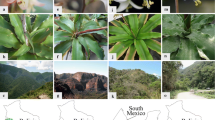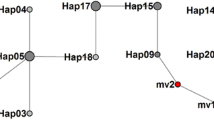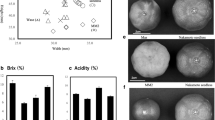Abstract
Hybrids between European and Japanese larches combine the properties of both parental species (drought resistance, canker resistance, stem straightness) and exhibit a fast growth rate. They are produced in seed orchards, generally by natural pollination. Seeds are collected and used for afforestation as interspecific hybrids. However, there are no convenient tests to assess the interspecific hybrid proportion. In the present study, we developed diagnostic molecular markers suitable for the individual identification of hybrids, whatever their developmental stage. Our strategy involved testing a combination of maternally inherited markers from the mitochondrial genome (mtDNA) and paternally inherited markers from the chloroplast genome (cpDNA). Hybrids were then identified by the presence of a mitochondrial sequence inherited from one parental species and a chloroplast sequence inherited from the other parental species. To achieve this aim, markers discriminating both parental species were first sought. Amplifications of mitochondrial and chloroplast sequences were performed using specific PCR primers. After testing 33 primer pairs in combination with nine restriction enzymes, we detected one mitochondrial marker, f13 which was amplified in Japanese larch and absent in European larch, and one chloroplast marker, ll-TaqI which showed different restriction patterns depending on the species. A restriction fragment of 601 bp was obtained in Japanese larch while two fragments of 120 bp and 481 bp were observed in European larch. These patterns were found in all 197 individuals tested from the two pure species. These markers were then used for the evaluation of the hybrid proportion in a seed lot produced from seed orchards; this was assessed as between 43% and 53% depending on the parental species. The male and female parental species could be determined for each progeny.



Similar content being viewed by others
References
Bastien JC, Keller R (1980) Intérêts comparés du mélèze hybride (Larix×eurolepis Henry) avec les deux espèces parentes. Rev For Fr 32:521–530
Besnard G, Khadari B, Baradat P, Bervillé A (2002) Combination of chloroplast and mitochondrial DNA polymorphisms to study cytoplasm genetic differentiation in the olive complex (Olea europaea L.). Theor Appl Genet 105:139–144
Chen J, Tauer CG, Huang Y (2002) Paternal chloroplast inheritance patterns in pine hybrids detected with trnL-trnF intergenic region polymorphism. Theor Appl Genet 104:1307–1311
Demesure B, Sodzi N, Petit RJ (1995) A set of universal primers for amplification of polymorphic non-coding regions of mitochondrial and chloroplast DNA in plants. Mol Ecol 4:129–131
De Verno LL, Charest PJ, Bonen L (1993) Inheritance of mitochondrial DNA in the conifer Larix. Theor Appl Genet 86:383–388
Dumolin-Lapègue S, Demesure B, Fineschi S, Le Corre V, Petit RJ (1997a) Phylogeographic structure of white oaks throughout the European continent. Genetics 146:1475–1487
Dumolin-Lapègue S, Pemonge MH, Petit RJ (1997b) An enlarged set of consensus primers for the study of organelle DNA in plants. Mol Ecol 6:393–397
Dumolin-Lapègue S, Pemonge MH, Petit RJ (1998) Association between chloroplast and mitochondrial lineages in oaks. Mol Biol Evol 15:1321–1331
Ennos RA, Qian T (1994) Monitoring the output of a hybrid larch seed orchard using isozyme markers. Forestry 67:63–74
Govindaraju DR, Wagner DB, Smith GP, Dancik BP (1988) Chloroplast DNA variation within individual trees of a Pinus banksiana -Pinus contorta sympatric region. Can J For Res 18:1347–1350
Häcker M, Bergmann F (1991) The proportion of hybrids in seed from a seed orchard composed of two larch species (L. europaea and L. leptolepis). Ann Sci For 48:631–640
Hipkins VD, Krutovskii KV, Strauss SH (1994) Organelle genomes in conifers: structure, evolution, and diversity. For Genet 1:179–189
Jaramillo-Correa JP, Bousquet J, Beaulieu J, Isabel N, Perron M, Bouillé M (2003) Cross-species amplification of mitochondrial DNA sequence-tagged-site markers in conifers: the nature of polymorphism and variation within and among species in Picea. Theor Appl Genet 106:1353–1367
Jeandroz S, Frascaria-Lacoste N, Bousquet J (1996) Molecular recognition of the closely related Fraxinus excelsior and F. oxyphylla (Oleaceae) by RAPD markers. For Genet 3:237–242
Khasa PD, Newton CH, Rahman MH, Jaquish B, Dancik BP (2000) Isolation, characterization, and inheritance of microsatellite loci in alpine larch and western larch. Genome 43:439–448
Kobayashi K, Yoshikawa J, Suzuki M (2000) DNA identifiation of Picea species of the last glacial age in northern Japan. Jpn J Hist Bot 8:67–80
Lidholm J, Gustafsson P (1991) The chloroplast genome of the Gymnosperm Pinus contorta: a physical map and a complete collection of overlapping clones. Curr Genet 20:161–166
Lu MZ, Szmidt AE, Wang XR (1998) RNA editing in gymnosperms and its impact on the evolution of the mitochondrial coxI gene. Plant Mol Biol 37:225–234
Maier J (1992) Genetic variation in European larch (Larix decidua Mill.). Ann Sci For 49:39–47
Mitchell AF (1958) Establishment of a seed orchard for the production of hybrid larch seed. For Comm 138–147
Neale BB, Sederoff RR (1989) Paternal inheritance of chloroplast DNA and maternal inheritance of mitochondrial DNA in loblolly pine. Theor Appl Genet 77:212–216
Palmer JD, Herbon LA (1988) Plant mitochondrial DNA evolves rapidly in structure, but slowly in sequence. J Mol Evol 28:87–97
Pâques LE (1989) A critical review of larch hybridization and its incidence on breeding strategies. Ann Sci For 46:141–153
Petit RJ, Demesure B, Dumolin S (1998) cpDNA and mtDNA primers in plants. In: Karp A, Isaac PG, Ingram D (eds) Molecular tools for screening biodiversity: plants and animals. Chapman and Hall, London, pp 256–261
Philippe G, Baldet P (1992) Mechanized pollen harvesting with a view to hybrid larch seed production. Ann Sci For 49:297–303
Qian T, Ennos RA, Helgason T (1995) Genetic relationships among larch species based on analysis of restriction fragment variation for chloroplast DNA. Can J For Res 25:1197–1202
Scheepers D, Eloy MC, Briquet M (2000) Identification of larch species (Larix decidua, Larix kaempferi and Larix×eurolepis) and estimation of hybrid fraction in seed lots by RAPD fingerprints. Theor Appl Genet 100:71–74
Sederoff RR (1987) Molecular mechanisms of mitochondrial-genome evolution in higher plants. Am Nat 130:S30–S45
Sutton BCS, Flanagan DJ, Gawley JR, Newton CH, Lester DT, El-Kassaby YA (1991) Inheritance of chloroplast and mitochondrial DNA in Picea and composition of hybrids from introgression zones. Theor Appl Genet 82:242–248
Szmidt AE, Aldén T, Hällgren JE (1987) Paternal inheritance of chloroplast DNA in Larix. Plant Mol Biol 9:59–64
Taberlet P, Gielly L, Pautou G, Bouvet J (1991) Universal primers for the amplification of the non-coding regions of chloroplast DNA. Plant Mol Biol 17:1105–1109
Testolin R, Cipriani G (1997) Paternal inheritance of chloroplast DNA and maternal inheritance of mitochondrial DNA in the genus Actinidia. Theor Appl Genet 94:897–903
Tsumura Y, Yoshimura K, Tomaru N, Ohba K (1995) Molecular phylogeny of conifers using RFLP analysis of PCR-amplified specific chloroplast genes. Theor Appl Genet 91:1222–1236
Vendramin GG, Anzidei M, Madaghiele A, Bucci G (1998) Distribution of genetic diversity in Pinus pinaster Ait. as revealed by chloroplast microsatellites. Theor Appl Genet 97:456–463
Wakasugi T, Tsudzuki J, Ito S, Shidata M, Sugiura M (1994) A physical map and clone bank of the black pine (Pinus thunbergii) chloroplast genome. Plant Mol Biol Rep 12:227–241
Wang WY, Pai RC, Lai CC, Tin TP (1994) Molecular evidence for the hybrid origin of Paulownia taiwaniana based on RAPD markers and RFLP of chloroplast DNA. Theor Appl Genet 89:217–275
Wang XR, Szmidt AE (1994) Hybridization and chloroplast DNA variation in a Pinus species complex from Asia. Evolution 48:1020–1031
Wang XR, Tsumura Y, Yoshimaru H, Nagasaka K, Szmidt AE (1999) Phylogenetic relationships of Eurasian pines (Pinus pinaceae) based on chloroplast rbcL, matK, rpl20-rps18 spacer, and trnV intron sequences. Am J Bot 86:1742–1753
Wei XX, Wang XQ (2003) Phylogenetic split of Larix: evidence from paternally inherited cpDNA trnT-trnF region. Plant Syst Evol 239:67–77
Wolfe KH, Wen-Hsiung LI, Sharp PM (1987) Rates of nucleotide substitution vary greatly among plant mitochondrial, chloroplast, nuclear DNAs. Proc Natl Acad Sci USA 84:9054–9058
Wu J, Krutovskii KV, Strauss SH (1998) Abundant mitochondrial genome diversity population differentiation and convergent evolution in pines. Genetics 150:1605–1614
Acknowledgements
We are grateful to Dominique Scheepers who identified the mtDNA marker and gave us its primer pair sequences. We thank Dominique Jacques for providing us with the seeds from the Halle orchard. We would like to thank Meredith Carter for manuscript correction. We express our thanks to Anne Arcade and Brigitte Demesure for encouragement and valuable discussions. We also thank Gérard Aubard for technical help. This work was supported by the European Union (project LARCH: FAIR-CT98-3354) and the French “Ministère de l’Agriculture et de la Pêche” (DERF grant no. 01.40.12/99).
Author information
Authors and Affiliations
Corresponding author
Additional information
Communicated by D.B. Neale
Rights and permissions
About this article
Cite this article
Acheré, V., Faivre Rampant, P., Pâques, L.E. et al. Chloroplast and mitochondrial molecular tests identify European×Japanese larch hybrids. Theor Appl Genet 108, 1643–1649 (2004). https://doi.org/10.1007/s00122-004-1595-y
Received:
Accepted:
Published:
Issue Date:
DOI: https://doi.org/10.1007/s00122-004-1595-y




